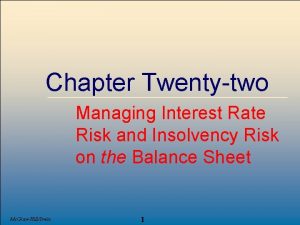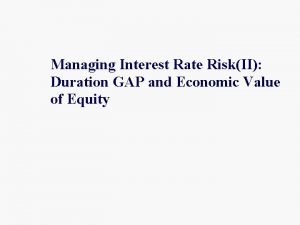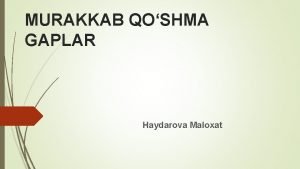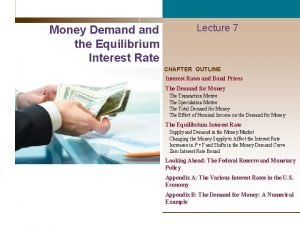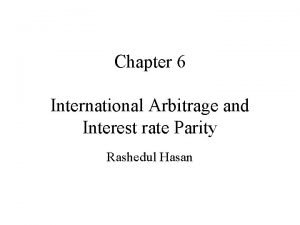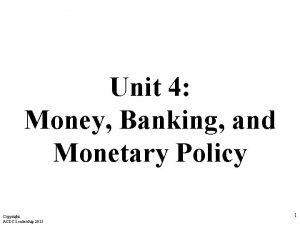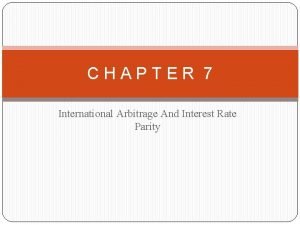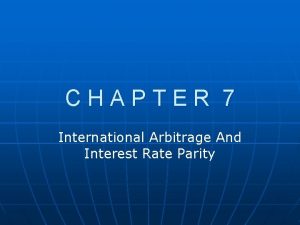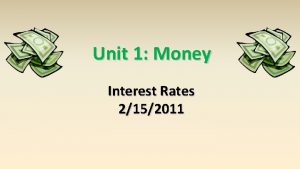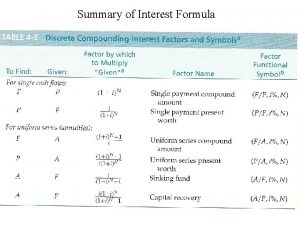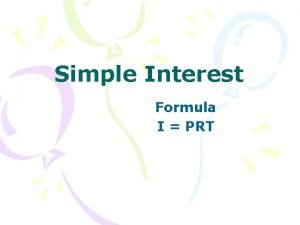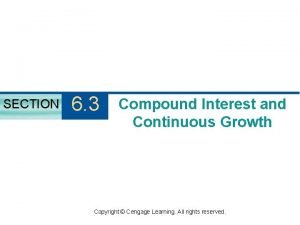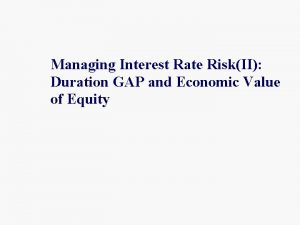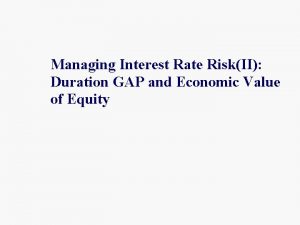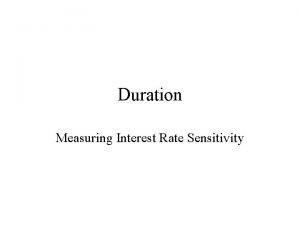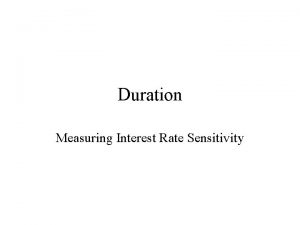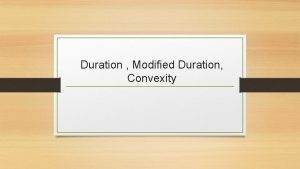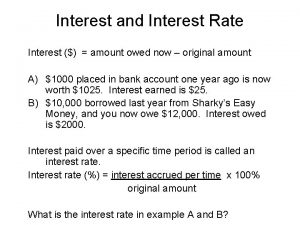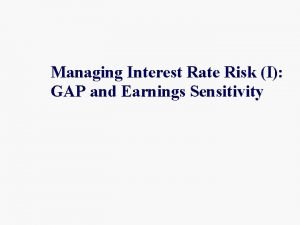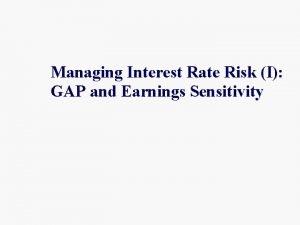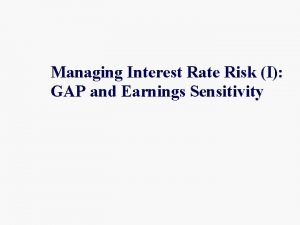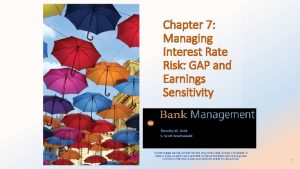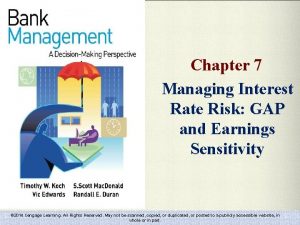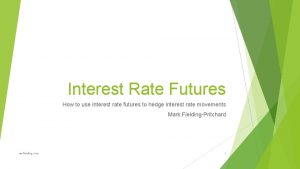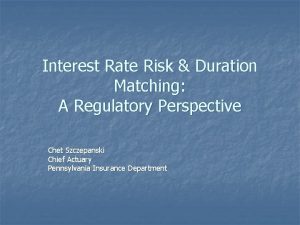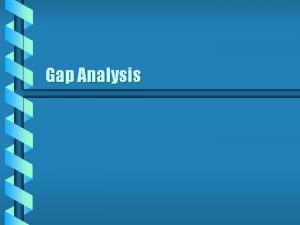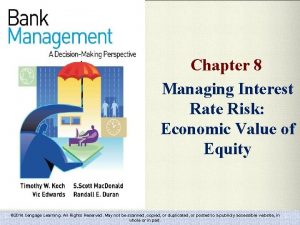Managing Interest Rate RiskII Duration GAP and Economic





























- Slides: 29

Managing Interest Rate Risk(II): Duration GAP and Economic Value of Equity

Measuring Interest Rate Risk with Duration GAP n Economic Value of Equity Analysis n Focuses on changes in stockholders’ equity given potential changes in interest rates n Duration GAP Analysis n Compares the price sensitivity of a bank’s total assets with the price sensitivity of its total liabilities to assess the impact of potential changes in interest rates on stockholders’ equity.

Duration GAP n Duration GAP Model n Focuses on either managing the market value of stockholders’ equity n The bank can protect EITHER the market value of equity or net interest income, but not both n Duration GAP analysis emphasizes the impact on equity n Compares the duration of a bank’s assets with the duration of the bank’s liabilities and examines how the economic value stockholders’ equity will change when interest rates change.

Steps in Duration GAP Analysis n Forecast interest rates. n Estimate the market values of bank assets, liabilities and stockholders’ equity. n Estimate the weighted average duration of assets and the weighted average duration of liabilities. n Incorporate the effects of both on- and offbalance sheet items. These estimates are used to calculate duration gap. n Forecasts changes in the market value of stockholders’ equity across different interest rate environments.

Weighted Average Duration of Bank Assets n Weighted Average Duration of Bank Assets (DA) n Where wi = Market value of asset i divided by the market value of all bank assets n Dai = Macaulay’s duration of asset i n n = number of different bank assets n

Weighted Average Duration of Bank Liabilities n Weighted Average Duration of Bank Liabilities (DL) n Where zj = Market value of liability j divided by the market value of all bank liabilities n Dlj= Macaulay’s duration of liability j n m = number of different bank liabilities n

Duration GAP and Economic Value of Equity n Let MVA and MVL equal the market values of assets and liabilities, respectively. n If: and Duration GAP n Then: where y = the general level of interest rates n To protect the economic value of equity against any change when rates change , the bank could set the duration gap to zero: n

Hypothetical Bank Balance Sheet

Calculating DGAP n DA n ($700/$1000)*2. 69 + ($200/$1000)*4. 99 = 2. 88 n DL n ($620/$920)*1. 00 + ($300/$920)*2. 81 = 1. 59 n DGAP n 2. 88 - (920/1000)*1. 59 = 1. 42 years n What does this tell us? § The average duration of assets is greater than the average duration of liabilities; thus asset values change by more than liability values.

1 percent increase in all rates.

Calculating DGAP n DA n ($683/$974)*2. 68 + ($191/$974)*4. 97 = 2. 86 n DA n ($614/$906)*1. 00 + ($292/$906)*2. 80 = 1. 58 n DGAP n 2. 86 - ($906/$974) * 1. 58 = 1. 36 years n What does 1. 36 mean? § The average duration of assets is greater than the average duration of liabilities, thus asset values change by more than liability values.

Change in the Market Value of Equity n In this case:

Positive and Negative Duration GAPs n Positive DGAP n Indicates that assets are more price sensitive than liabilities, on average. n Thus, when interest rates rise (fall), assets will fall proportionately more (less) in value than liabilities and EVE will fall (rise) accordingly. n Negative DGAP n Indicates that weighted liabilities are more price sensitive than weighted assets. n Thus, when interest rates rise (fall), assets will fall proportionately less (more) in value that liabilities and the EVE will rise (fall).

DGAP Summary

An Immunized Portfolio n To immunize the EVE from rate changes in the example, the bank would need to: n decrease the asset duration by 1. 42 years or n increase the duration of liabilities by 1. 54 years n DA / ( MVA/MVL) = 1. 42 / ($920 / $1, 000) = 1. 54 years

Immunized Portfolio DGAP = 2. 88 – 0. 92 (3. 11) ≈ 0

Immunized Portfolio with a 1% increase in rates

Immunized Portfolio with a 1% increase in rates n EVE changed by only $0. 5 with the immunized portfolio versus $25. 0 when the portfolio was not immunized.

Economic Value of Equity Sensitivity Analysis n Effectively involves the same steps as earnings sensitivity analysis. n In EVE analysis, however, the bank focuses on: n The relative durations of assets and liabilities n How much the durations change in different interest rate environments n What happens to the economic value of equity across different rate environments

Embedded Options n Embedded options sharply influence the estimated volatility in EVE n Prepayments that exceed (fall short of) that expected will shorten (lengthen) duration. n A bond being called will shorten duration. n A deposit that is withdrawn early will shorten duration. n A deposit that is not withdrawn as expected will lengthen duration.

Assets First Savings Bank Economic Value of Equity Market Value/Duration Report as of 12/31/04 Most Likely Rate Scenario-Base Strategy

Liabilities First Savings Bank Economic Value of Equity Market Value/Duration Report as of 12/31/04 Most Likely Rate Scenario-Base Strategy

Duration Gap for First Savings Bank EVE n Market Value of Assets n $1, 001, 963 n Duration of Assets n 2. 6 years n Market Value of Liabilities n $919, 400 n Duration of Liabilities n 2. 0 years

Duration Gap for First Savings Bank EVE n Duration Gap n = 2. 6 – ($919, 400/$1, 001, 963)*2. 0 = 0. 765 years n Example: n A 1% increase in rates would reduce EVE by $7. 2 million = 0. 765 (0. 01 / 1. 0693) * $1, 001, 963 n Recall that the average rate on assets is 6. 93%

Effective “Duration” of Equity n By definition, duration measures the percentage change in market value for a given change in interest rates n Thus, a bank’s duration of equity measures the percentage change in EVE that will occur with a 1 percent change in rates: n Effective duration of equity 9. 9 yrs. = $8, 200 / $82, 563

Asset/Liability Sensitivity and DGAP n Funding GAP and Duration GAP are NOT directly comparable n Funding GAP examines various “time buckets” while Duration GAP represents the entire balance sheet. n Generally, if a bank is liability (asset) sensitive in the sense that net interest income falls (rises) when rates rise and vice versa, it will likely have a positive (negative) DGAP suggesting that assets are more price sensitive than liabilities, on average.

Strengths and Weaknesses: DGAP and EVESensitivity Analysis n Strengths n Duration analysis provides a comprehensive measure of interest rate risk n Duration measures are additive n This allows for the matching of total assets with total liabilities rather than the matching of individual accounts n Duration analysis takes a longer term view than static gap analysis

Strengths and Weaknesses: DGAP and EVESensitivity Analysis n Weaknesses n It is difficult to compute duration accurately n “Correct” duration analysis requires that each future cash flow be discounted by a distinct discount rate n A bank must continuously monitor and adjust the duration of its portfolio n It is difficult to estimate the duration on assets and liabilities that do not earn or pay interest n Duration measures are highly subjective

Speculating on Duration GAP n It is difficult to actively vary GAP or DGAP and consistently win n Interest rates forecasts are frequently wrong n Even if rates change as predicted, banks have limited flexibility in vary GAP and DGAP and must often sacrifice yield to do so
 Real vs nominal interest rate
Real vs nominal interest rate Interest rate duration
Interest rate duration Cap rate interest rate relationship
Cap rate interest rate relationship Equity duration
Equity duration Duration gap
Duration gap Nim formula
Nim formula Compound interest meaning
Compound interest meaning Managing economic exposure and translation exposure
Managing economic exposure and translation exposure Exposure
Exposure Measuring economic exposure
Measuring economic exposure Managing economic exposure and translation exposure
Managing economic exposure and translation exposure Managing economic exposure and translation exposure
Managing economic exposure and translation exposure Interest rates and economic growth
Interest rates and economic growth Nominal rate
Nominal rate Interest sensitive gap management
Interest sensitive gap management Ergashgan qoshma gap
Ergashgan qoshma gap Compiler bridges the semantic gap between which domains?
Compiler bridges the semantic gap between which domains? Money demand and interest rate
Money demand and interest rate Locational arbitrage
Locational arbitrage Decreasing money supply
Decreasing money supply Covered interest rate arbitrage
Covered interest rate arbitrage Locational arbitrage
Locational arbitrage Conclusion of growth and development
Conclusion of growth and development Interest rate effect
Interest rate effect Discrete compounding formula
Discrete compounding formula Given the formula i= prt, the formula for t is
Given the formula i= prt, the formula for t is Amount in math
Amount in math How to write compound interest formula
How to write compound interest formula Nominal vs real return
Nominal vs real return Real interest rate formula
Real interest rate formula

